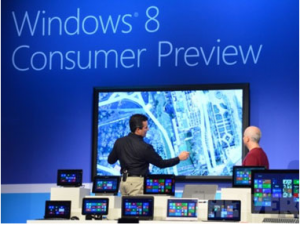PPI Perceptive Pixel Display July 2012 shown running Win8, Source: AllthingsD.com
 Emerging Technology – Down Australia way it’s the end of a long winter and coming into spring, a fitting place for news of a resurgence of the somewhat dormant Perceptive Pixel Inc. (PPI) now owned by Microsoft (MS.) There we heard the recent revelation this big screen touch technology is moving into mass production according to MS Device group VP, Stephen Elop. He also told the group of Microsoft faithful at a recent Partners Conference Down Under, that Perceptive Pixel Touch Displays will play an important role as part of Microsoft’s grand hardware/software strategy.
Emerging Technology – Down Australia way it’s the end of a long winter and coming into spring, a fitting place for news of a resurgence of the somewhat dormant Perceptive Pixel Inc. (PPI) now owned by Microsoft (MS.) There we heard the recent revelation this big screen touch technology is moving into mass production according to MS Device group VP, Stephen Elop. He also told the group of Microsoft faithful at a recent Partners Conference Down Under, that Perceptive Pixel Touch Displays will play an important role as part of Microsoft’s grand hardware/software strategy.
Seems the PPI technology is at the nexus of touch/pen I/O that has become pervasive among the disparate groups at the Redmond, WA based software behemoth. Case in point, the Unified OS Group is looking towards a “One Windows” platform initiative to “streamline” the next version of Windows (Win 9) that will include closer alignment with the touch pen interface technology. In part, Windows One is an aggressive effort to combine the Windows Phone OS, Windows Embedded, Windows (for PCs and tablets) and the Xbox One operating systems using some kind of single “NT core.”
Remember, for Microsoft it’s all about devices and services now as the company is looking to right itself from the missed search, browsing and mobile opportunities that transformed the digital landscape away from a desktop-centric world earlier in the decade. At first blush, one saw the Perceptive Pixel technology adding to Office and OneNote products plus Skype and Business Intelligence (BI) service initiatives. Essentially note and meeting technology focused. But this combined with the launch of Windows 8 and its laser focus on touch interface, helped solidify the PPI hardware platform’s fate at the company with its integrated touch display (55″ and 82″ diagonal) and collaborative freedom of unlimited touches and pen stylus input and control.
And while Perceptive Pixel is at the large size device end of the spectrum, there are indeed key elements that also apply to all parts of the ecosystem, as Microsoft works to “delight” its users, not just serve utilitarian needs, according to Terry Meyerson, in an April-14 zdnet.com interview. Meyerson is heading the unified OS group for the company, and said the large shared screen experience can be used not just in conferencing, but as a platform springboard, in CRM perhaps or Gaming (Xbox) as the company opens up the tools to the ISV (independent software vendor) community to explore and create next generation apps.
PPI went rather dark for many months after software giant Microsoft bought the company in 2012, in a bid to help with the monumental move to a touch-based OS (Win8) interface. Early versions of the 82″ multi-touch display sold for roughly $1000/inch or as much as $82K, under strict control and direct distribution requirements. More recently the PPI technology is available at CDW and other online retailers at a price pushing $10K. That’s $7,489 (55-inch version part no. 6FV-00013) and another $2900 (part no. 6FV-00015) for the fixed vertical stand to hold it up. As of this writing, there is still no online price for the larger 82″ model.
So will prices begin to drop with PPI technology mass produced? And perhaps more importantly, can MS find a break-out market for the big screen interactive touch device that will help usher in the world of desktop touch on the mainstream Windows 8 platform? We’ll see. – Steve Sechrist

